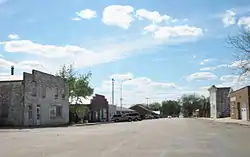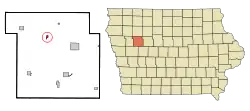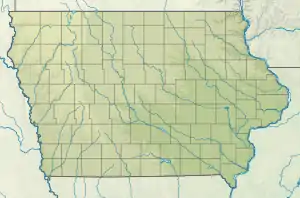Early, Iowa
Early is a city in Sac County, Iowa, United States. The population was 557 at the 2010 census.
Early, Iowa | |
|---|---|
 | |
| Motto(s): "Crossroads Of The Nation"[1] | |
 Location of Early, Iowa | |
 Early Location within Iowa  Early Location within the United States | |
| Coordinates: 42°27′43″N 95°9′5″W | |
| Country | |
| State | |
| County | Sac |
| Township | Boyer Valley |
| Area | |
| • Total | 0.39 sq mi (1.01 km2) |
| • Land | 0.39 sq mi (1.01 km2) |
| • Water | 0.00 sq mi (0.00 km2) |
| Elevation | 1,345 ft (410 m) |
| Population | |
| • Total | 557 |
| • Estimate (2019)[4] | 515 |
| • Density | 1,317.14/sq mi (508.14/km2) |
| Time zone | UTC-6 (Central (CST)) |
| • Summer (DST) | UTC-5 (CDT) |
| ZIP code | 50535 |
| Area code(s) | 712 |
| FIPS code | 19-23475 |
| GNIS feature ID | 0456107 |
| Website | City of Early, Iowa |
History
Early was incorporated on May 22, 1883,[5] and is named after D.C. Early, a local settler.[6][7]
Geography
Early is located at 42°27′43″N 95°9′5″W (42.461903, -95.151290).[8]
According to the United States Census Bureau, the city has a total area of 0.39 square miles (1.01 km2), all land.[9]
Demographics
| Year | Pop. | ±% |
|---|---|---|
| 1890 | 277 | — |
| 1900 | 579 | +109.0% |
| 1910 | 500 | −13.6% |
| 1920 | 568 | +13.6% |
| 1930 | 632 | +11.3% |
| 1940 | 644 | +1.9% |
| 1950 | 742 | +15.2% |
| 1960 | 824 | +11.1% |
| 1970 | 727 | −11.8% |
| 1980 | 670 | −7.8% |
| 1990 | 649 | −3.1% |
| 2000 | 605 | −6.8% |
| 2010 | 557 | −7.9% |
| 2019 | 515 | −7.5% |
| Source:"U.S. Census website". United States Census Bureau. Retrieved 2020-03-29. and Iowa Data Center Source: | ||
Early's "claim to fame" is that it is the Crossroads of the Nation, because U.S. Highway 71 and U.S. Route 20 intersect there.
2010 census
As of the census[3] of 2010, there were 557 people, 246 households, and 146 families living in the city. The population density was 1,428.2 inhabitants per square mile (551.4/km2). There were 287 housing units at an average density of 735.9 per square mile (284.1/km2). The racial makeup of the city was 93.2% White, 1.4% African American, 0.2% Native American, 0.2% Asian, 0.5% Pacific Islander, 3.1% from other races, and 1.4% from two or more races. Hispanic or Latino of any race were 4.5% of the population.
There were 246 households, of which 27.6% had children under the age of 18 living with them, 47.6% were married couples living together, 9.3% had a female householder with no husband present, 2.4% had a male householder with no wife present, and 40.7% were non-families. 34.6% of all households were made up of individuals, and 13% had someone living alone who was 65 years of age or older. The average household size was 2.26 and the average family size was 2.95.
The median age in the city was 40.9 years. 25.5% of residents were under the age of 18; 6.3% were between the ages of 18 and 24; 24% were from 25 to 44; 27.7% were from 45 to 64; and 16.5% were 65 years of age or older. The gender makeup of the city was 49.4% male and 50.6% female.
2000 census
As of the census[11] of 2000, there were 605 people, 258 households, and 166 families living in the city. The population density was 1,532.3 people per square mile (599.0/km2). There were 293 housing units at an average density of 742.1 per square mile (290.1/km2). The racial makeup of the city was 96.03% White, 0.66% African American, 0.17% Native American, 2.31% from other races, and 0.83% from two or more races. Hispanic or Latino of any race were 4.13% of the population.
There were 258 households, out of which 32.6% had children under the age of 18 living with them, 56.2% were married couples living together, 7.0% had a female householder with no husband present, and 35.3% were non-families. 32.9% of all households were made up of individuals, and 15.5% had someone living alone who was 65 years of age or older. The average household size was 2.34 and the average family size was 2.97.
27.8% were under the age of 18, 8.3% from 18 to 24, 27.1% from 25 to 44, 18.3% from 45 to 64, and 18.5% were 65 years of age or older. The median age was 37 years. For every 100 females, there were 86.2 males. For every 100 females age 18 and over, there were 86.0 males.
The median income for a household in the city was $30,972, and the median income for a family was $40,521. Males had a median income of $27,778 versus $18,929 for females. The per capita income for the city was $14,317. About 8.1% of families and 12.1% of the population were below the poverty line, including 12.0% of those under age 18 and 9.4% of those age 65 or over.
Education
Early is a part of the Schaller-Crestland Community School District.[12] The district formed on July 1, 1993, by the merger of the Schaller Community School District and the Crestland Community School District.[13]
Before the merger with Schaller, Early community schools were in a consolidated school district with Nemaha Community a school. This began in 1958. Their mascot was the Cadets.
Early School district was the predated district before the consolidation with Nemaha. They were known as the Cardinals.
Song

The city is the topic of the song "Early", by folk musician Greg Brown. It appears on his album 44 & 66, released in 1980.
Murder of Dustin Wehde
In August 2011, Tracey Ann Richter was charged with first-degree murder and was convicted by a jury in November 2011. On June 1, 2012, Dateline NBC aired a two-hour episode titled "Twisted", about the 2001 shooting death of Early resident Dustin Wehde. Tracey Richter, a neighbor of Wehde's, was convicted of first-degree murder on November 7, 2011 and sentenced to life in prison without the possibility of parole [Case No. FECR011900]. Richter appealed her conviction.[14][15] On January 9, 2013, the Iowa Court of Appeals upheld the conviction of Tracey Ann Richter.[16]
References
- "City of Early, Iowa". City of Early, Iowa. Retrieved September 2, 2012.
- "2019 U.S. Gazetteer Files". United States Census Bureau. Retrieved July 17, 2020.
- "U.S. Census website". United States Census Bureau. Retrieved 2012-05-11.
- "Population and Housing Unit Estimates". United States Census Bureau. May 24, 2020. Retrieved May 27, 2020.
- "Early, Iowa". City-Data.com. Retrieved September 2, 2012.
- "Profile for Early, Iowa, IA". ePodunk. Retrieved September 2, 2012.
- Chicago and North Western Railway Company (1908). A History of the Origin of the Place Names Connected with the Chicago & North Western and Chicago, St. Paul, Minneapolis & Omaha Railways. p. 66.
- "US Gazetteer files: 2010, 2000, and 1990". United States Census Bureau. 2011-02-12. Retrieved 2011-04-23.
- "US Gazetteer files 2010". United States Census Bureau. Archived from the original on 2012-07-02. Retrieved 2012-05-11.
- "Census of Population and Housing". Census.gov. Retrieved June 4, 2015.
- "U.S. Census website". United States Census Bureau. Retrieved 2008-01-31.
- "Schaller-Crestland." Iowa Department of Education. Retrieved on November 3, 2018.
- "REORGANIZATION & DISSOLUTION ACTIONS SINCE 1965-66." Iowa Department of Education. Retrieved on November 3, 2018.
- "In Dateline NBC interview Richter denies plot to murder Wehde". KTIV.com. June 1, 2012. Archived from the original on June 3, 2012. Retrieved June 1, 2012.
- "Murder victim's mother on 'Today'". KTIV.com. June 1, 2012. Retrieved June 1, 2012.
- Miller, Ashley (11 January 2013). "Appeals court denies Richter's murder appeal". Pilot Tribune. Archived from the original on 3 April 2014. Retrieved 3 April 2014.
External links
- City of Early, Iowa Website Portal style website, Government, Business, Library, Recreation and more
- City-Data.com Comprehensive Statistical Data and more about Early